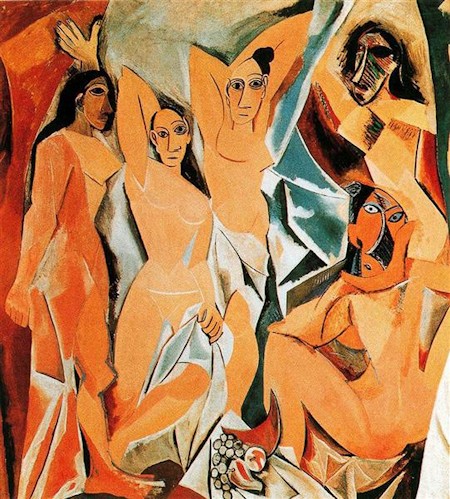Pablo PICASSO
Pablo Picasso is probably the most important artist of the 20th century. He was born in Malaga in Spain in 1881 and grew up in Barcelona. Picasso had a very long and successful career as an artist living until the age of 92. He was the son of an art teacher who taught him to draw from a very early age. Pablo was quite capable of drawing a pigeon, almost realistically, at the age of five. He held his first exhibition at the age of 16, before moving to Paris where he settled in 1904. Here he became friendly with the artist Georges Braque, with whom he later developed Cubism, and writers Max Jacob and Guillaume Apollinaire.
Blue and Rose Periods
In Paris he developed numerous styles of painting. The first was known as the Blue Period and dates from 1901 to 1904. It is easily recognised by the predominantly blue colour of the paintings. The subjects are often outcasts, beggars, and prostitutes. Picasso also produced a lot of sculptures around this time.
Teaching an Art lesson on Pablo Picasso? Checkout this lesson idea.
When the Blue Period came to an end in 1904 Picasso began his Rose Period. The colours of his paintings brightened, with lots of pinks and beiges, light blues, and reds. His subject matter also changed to circus people, harlequins, and clowns, all of whom seem to be mute and strangely inactive. Paintings produced at this time show that he was much happier with himself and his work.
Cubism
In 1907 Picasso discovered African art after seeing sculptures from Africa in an exhibition. He noticed how simply they were carved and began to experiment with the same ideas in his paintings. He began to look at objects in his paintings (figures, tables, vases, backgrounds) as just a collection of shapes that he could rearrange. Picasso wanted to be able to produce a painting from different viewpoints, like we can do when we walk around a sculpture. There strange paintings became known as Cubism. Perhaps the most famous was Les Demoiselles d’Avignon, a group of naked women, which he painted in 1907.
Almost every famous painter of the time began to experiment with Cubism. As a result Picasso and his friend, the artist Georges Braque became very famous. In New York in 1913 the Americans were introduced to this new style of painting in a famous exhibition called the Armory Show – it was a sensational success.
Picasso Invents Collage
Picasso was always looking for new ways to paint and experiment with art. In his still life paintings of 1912, he was painting bits of newspaper, cigarette packets and letters as well as other objects. He realised it would be much quicker and just as effective if he stuck these objects to his paintings. As a result he invented Collage.
From 1914 onwards, well into the 1920’s he worked on stage sets and costumes for the Ballet Russe. A ballet company that had been based in Italy. During the 1920’s he abandoned his Cubist style of painting for a more realistic, or classical style. His figures were no longer chopped up into shapes as they had been in his Cubist phase. They were now painted large and rounded and looked as though they originated in Ancient Greece.
During the 1930’s he also dabbled with Surrealism, a very strange way of painting where the ideas for paintings come from dreams and nightmares.
Guernica
In January 1937, the Republican government of Spain asked him to paint a mural for the Spanish pavilion at the world exposition in Paris. He decided to paint ‘Guernica’ which is probably his greatest painting. It is a painting that records the bombing and total destruction of the Basque town of Guernica during the Spanish Civil war. It is a huge and very controversial picture that expresses a great revulsion about the horrors man can wreak upon his fellow man. A grieving woman dominates the centre of the painting together with a wounded screaming horse. They are illuminated by a harsh light and painted in blacks, whites and greys.
Later Years
In Picasso’s later years he turned enthusiastically to creating sculpture, pottery, and printmaking, and also preoccupied himself with a series of mistresses and girlfriends, changing his style to express his love for each one. Finally, he worked on his own versions of paintings by old masters like Diego Velazquez that were quite wonderful.
Picasso had the ability to add that “unquenchable spark of utter genius” to almost everything he produced throughout his whole life. Without doubt Picasso is one of the most influential, original and creative artists the world has seen.
Planning on using Pablo Picasso as the basis of an art lesson? Check out these ideas




